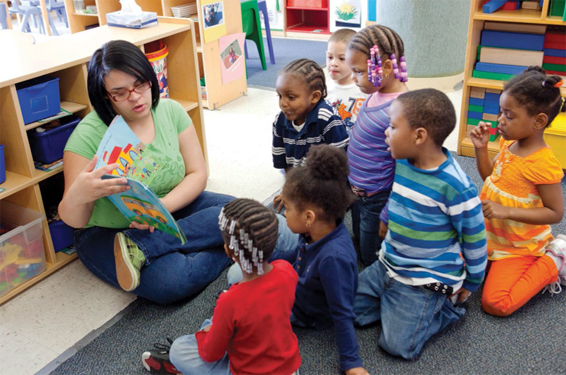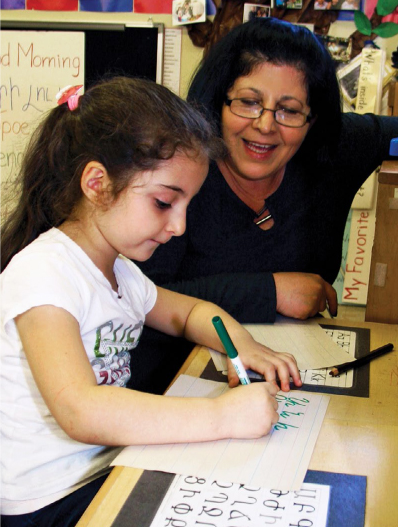Language and Literacy
Communication is fundamental to the human experience, and language and literacy are essential to children's learning.

Language development refers to emerging abilities in listening and understanding (receptive language) and in using language (expressive language). Babies attend to the sounds of language in their environment before they are born. In the context of nurturing, responsive adult relationships, infants rapidly learn to communicate with facial expressions, gestures, and looks. They move from babbling to understanding many words spoken to them and then uttering or signing their first words. Toddlers learn to speak new words at an amazing pace and use language to express their needs, ask questions, and engage in short conversations.
Language skills continue to expand, and by the end of the preschool period, children speak in adult-like sentences, tell and re-tell stories, use verbal humor, and engage in group discussions. Preschoolers are sophisticated language users who harness language in order to take in new and complex information and organize their world. As they delve into new learning experiences, they add mathematical or scientific terms to their vocabulary, such as semi-circle or T-Rex. They begin to understand word categories, such as hammers and screwdrivers are tools, and relationships among words, such as the opposite of up is down. Preschoolers with strong language skills are prepared to be successful learners in school.
Language and literacy skills can develop in any language, and for the most part, they develop first in the child's home language. Supporting development of the home language helps prepare young children for learning English. Children who are dual language learners (DLLs) show different patterns of English acquisition, depending on their prior exposure, their abilities, their temperaments, and the support they receive at home and in the early childhood program. Some children who are DLLs may use different vocabulary and sentence structure in each language.

Children's language ability affects learning and development in all areas, especially emerging literacy. Emerging literacy refers to the knowledge and skills that lay the foundation for reading and writing. For infants and toddlers, emerging literacy is embedded in the domain Language and Communication, reflecting the interrelatedness of these learning areas and the limited scope of these budding skills. As infants and toddlers listen to and repeat songs and rhymes, explore books, and hear stories, they are gaining literacy skills. By 3 years of age, children can understand the pictures in familiar books and ask what is happening. They make scribbles, shapes, and even letter-like marks on paper that may represent something to them.
For preschoolers, Language and Literacy are distinct domains to reflect the differentiation, centrality, breadth, and depth of language and literacy development in this age period. Preschoolers are beginning to grasp how written language is structured into sounds and symbols. They play rhyming games and learn the names of letters and associated sounds. They take pride in recognizing their name in print and practice writing it. Preschoolers begin to understand print conventions and the different functions of print in picture books or grocery lists. As they listen to and talk about story books or retell and enact events, they gain an understanding of sequence, character development, and causal relationships. When preschoolers are engaged literacy learners, they are laying the foundation for becoming capable readers and writers in school.
Children with disabilities may need extra support when they are learning to communicate. They may need listening devices to help them hear or assistive tools to help them speak or write clearly. Depending on the child's needs, programs can support the development of sign language as a means of communication. Programs must promote language and literacy outcomes through appropriate and intentional support so that all children can develop strong skills in language and literacy.
Programs must promote language and literacy goals for all children. Children who are dual language learners (DLLs) need intentional support for the development of their home language as well as for English acquisition.
Last Updated: May 21, 2024
